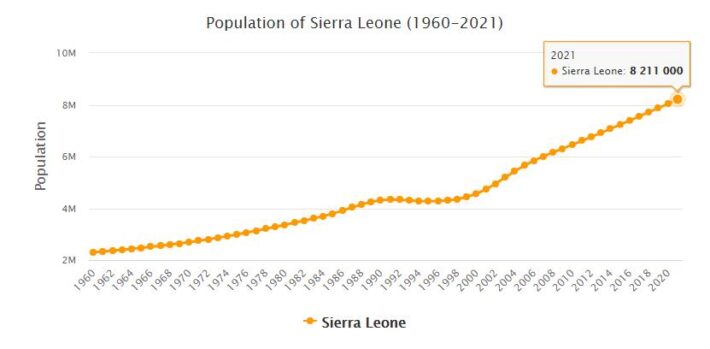Yearbook 2012
Sierra Leone. In April, the Special Court of Sierra Leone sentenced the warlord and former Liberian president, Charles Taylor, to several cases of war crimes during the civil war in Sierra Leone 1991–2002. One month later, the sentence against him was announced to 50 years in prison for, among other crimes, against humanity.
The Special Court for Sierra Leone was established in 2002 through an agreement between the country’s government and the UN, with the mission to prosecute and convict persons responsible for serious violations of international humanitarian law and national law in connection with the civil war.
In November, presidential and parliamentary elections were held in the country. It was the first election since the Civil War that Sierra Leone organized on its own without UN supervision. Before the election, clashes occurred in the capital Freetown between supporters of the two largest parties, the General People’s Congress (APC) and the Sierra Leone People’s Party (SLPP). The election day was still relatively calm and turnout was high, just over 87%. In addition to a large number of domestic observers, foreign observers from both the EU and the African Union (AU) were also present to check that the election was successful.
- AbbreviationFinder.org: Provides most commonly used acronyms and abbreviations for Sierra Leone. Also includes location map, major cities, and country overview.
A week after the election, it was clear that the incumbent President, Ernest Bai Koroma, received the most votes and therefore has to stay for another term. Koroma won by almost 59% of the vote against opposition leader Julius Maada Bio, who got 38%. In the parliamentary elections, Koroma’s APC became the largest party with 67 seats in parliament. SLPP ended up in second place with 42 places. The EU subsequently judged that the elections were relatively fair, but the Union observers still criticized the state media favoring the APC in its pre-election reporting and that the party used state money in its election campaign.
During the year, the water-borne disease spread to cholera in several parts of the country and at the end of the year more than 200 people were reported to have fallen victim to the disease. According to the World Health Organization (WHO), almost half of Sierra Leone’s population do not have access to clean drinking water. Particularly flawed are the living conditions in the country’s slums, where diseases such as cholera risk spreading rapidly. In the UN list of development levels in the countries of the world in 2011, Sierra Leone ranked 182 out of 187.
Population 2012
According to countryaah, the population of Sierra Leone in 2012 was 7,171,803, ranking number 105 in the world. The population growth rate was 2.250% yearly, and the population density was 99.3615 people per km2.
HISTORY
Reached by Portuguese navigators in the 15th century, but probably already visited by Normans and Genoese, the region was an important base for the slave and gold trade. In 1787 it was chosen by the English philanthropist Granville Sharpe as a place of settlement for freed slaves, who formed a small elite in a prominent position compared to the original residents. In 1792 the first British governor took office and Freetown was founded, which with its immediate background enjoyed the status of “crown colony” from 1808; the territory of the interior was instead organized into a protectorate from 1896.
Independence within the Commonwealth was proclaimed in 1961. A hegemonic political force since the 1950s, the Sierra Leone People’s Party (SLPP, an expression above all of the native minority) ruled until 1967 when some military seized power; the following year, a new military coup put the leader of the All People’s Congress (APC), S. Stevens, at the head of the government. In 1971 the latter had to resort to the intervention of troops from nearby Guinea to foil a new military conspiracy; in the same year a republican constitution was passed and Stevens assumed the post of head of state. The legislative elections of 1973 and 1977 confirmed the dominance of the PCA, while Stevens was re-elected without rival in 1976 and 1978, the year in which a one-party regime was established. In the early 1980s, the consensus for the regime dropped significantly; the violence that accompanied the 1982 elections was joined by the outbreak of serious tribal conflicts in the district of Pujehun in 1983, with thousands of people forced to take refuge in neighboring Liberia. Designated by Stevens as his successor, General J. Momoh was elected President of the Republic in 1985; his administration proved unable to stop the deteriorating economic situation and widespread corruption of the regime, as the country suffered the consequences of its involvement in the conflict that erupted in Liberia in 1989. with thousands of people forced to take refuge in neighboring Liberia. Designated by Stevens as his successor, General J. Momoh was elected President of the Republic in 1985; his administration proved unable to stop the deteriorating economic situation and widespread corruption of the regime, as the country suffered the consequences of its involvement in the conflict that erupted in Liberia in 1989. with thousands of people forced to take refuge in neighboring Liberia. Designated by Stevens as his successor, General J. Momoh was elected President of the Republic in 1985; his administration proved unable to stop the deteriorating economic situation and widespread corruption of the regime, as the country suffered the consequences of its involvement in the conflict that erupted in Liberia in 1989.
